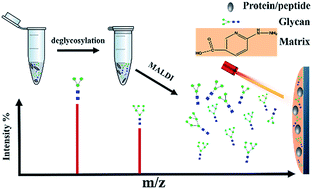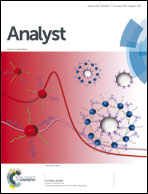Hydrazinonicotinic acid as a novel matrix for highly sensitive and selective MALDI-MS analysis of oligosaccharides†
Abstract
Analysis of oligosaccharides with matrix-assisted laser desorption/ionization mass spectrometry (MALDI-MS) remains challenging due to their low ionization efficiency. The sensitivity achieved by MS for oligosaccharides lags far behind that for proteins/peptides. Here, hydrazinonicotinic acid (HYNIC) is proposed as a new matrix to realize highly sensitive and selective analysis of oligosaccharides in MALDI-MS. The detection limit of maltoheptaose provided by HYNIC is as low as 1 amol, which is five orders of magnitude lower than that provided by the traditional matrix 2,5-dihydroxybenzoic acid (DHB). Interestingly, HYNIC displayed remarkable selectivity for ionization of oligosaccharides, making glycans from glycoproteins become more accessible to be detected even without pre-purification, as demonstrated by the direct detection of the oligosaccharides from human serum without pre-separation of the proteins/peptides. The HYNIC matrix also possessed the virtue of higher homogeneity of crystallization and better salt tolerance (up to 200 mM NaCl, 140 mM urea and 40 mM sulfocarbamide et al.) compared with the traditional matrix DHB. Furthermore, the HYNIC matrix afforded adequate fragmentation, thus providing rich information for the structural elucidation of the oligosaccharide. Therefore, using HYNIC as the matrix to directly analyze oligosaccharides is inherently simple and straightforward.


 Please wait while we load your content...
Please wait while we load your content...